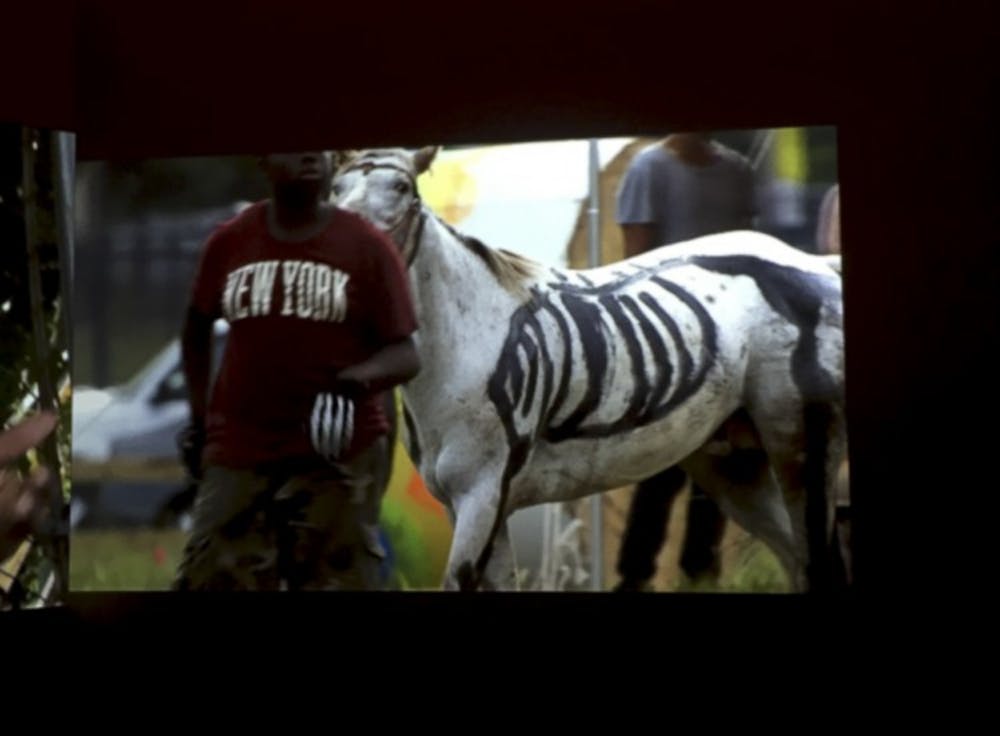The antiquated mythological figure of the American cowboy is predicated on manifest destiny: the 19th–century belief that US expansion throughout the American continents was both divinely justified and inevitable. In what ways does this ideological negligence persist in contemporary society? And how can it be overcome? Mohamed Bourouissa provokes these questions in Mohamed Bourouissa: Urban Riders, a must–see exhibition that politically dismantles the cowboy archetype by highlighting one North Philadelphia community’s symbolic rise above the neighborhood’s destructive economic circumstance.
Mohamed Bourouissa is an Algerian–born artist who lives and works in Paris. He is best known for his raw but elaborately choreographed photography on topics like the daily lives of young, working–class African immigrants and the adverse French penal system. He's interested in how marginalized populations can rebel and resist, and he portrays them with elegance and dignity. Collaboration lies at the core of both his subject and process. It's this passion which brought him to Philadelphia in 2014, to work with the Fletcher Street Urban Riding Club.
Philadelphia is home to upwards of 50 urban horse stables. Fletcher Street, part of North Philly’s Strawberry Mansion neighborhood, has maintained one of these stables for the past 100 years. It's commonly known that the area surrounding Fletcher Street has suffered greatly from a torrent of unemployment, crime, and drugs. Yet, the Fletcher Street Urban Riding Club survives as a vestige of the neighborhood’s heritage in the form of a community program, offering the men and boys of Fletcher Street a positive support system amidst chronic instability. They work together to train and care for their horses, and they collectively reinvent the city streets as urban riding routes.
Mohamed Bourouissa: Urban Riders is a large exhibition which documents and celebrates Horse Day: the horse show event that culminated Bourouissa’s nine month collaboration with Fletcher Street’s Urban Cowboys and artists. The show is a story, revealing the group’s personal and political sentiments through preliminary sketches, costume artifacts, a two–channel video installation, various ephemera, and reflective sculptures produced by the artist upon his return to Paris. An authentic vigor courses through the exhibition in the form of a few dominant visual motifs. These include a red and silver metallic cape, CD-plated horse armor, and a black skeleton spray painted onto the body of a white show horse.
Fletcher Street Urban Riding Club’s mission is the following:
“...to save and restore this historical, important facet of Philadelphia's community, and most importantly, its children. Fletcher Street's horse community is for many children, the only safe place to be mentored, to feel good about themselves, to learn important lessons in responsibility, discipline and reward. Many of the boys that frequent Fletcher Street have little to no support in life and the men on Fletcher Street have consistently taken it upon themselves to provide a positive environment and some facet of stability for those kids that have none. Fletcher Street is determined to preserve its legacy, children and horses.”
Given this, the presence of Bourouissa and the Fletcher Street community’s work at the Barnes Foundation has sparked controversy. Albert C Barnes, who founded of the museum in 1925, favored an intimate approach to art as a means of education and community development. His gallery served as a teaching tool, offering local, under served populations a chance to learn and interact with art that would otherwise be far out of reach. He frequently banned entitled, wealthy art patrons who demanded access to his 25 billion dollar collection, and he explicitly outlined in his will the enduring intention to protect the work from a pretentious, adulterated public institution of art viewership.
But after Barnes died in 1951, the city of Philadelphia began to change his plans. The 2009 film Art of the Steal outlines the financial crisis and struggle for control that followed Barnes’ passing. In short, between 2009 and 2012 the collection was moved from its original location in Lower Merion to its freshly built (current) home in Logan Square—prime arts real estate with questionable accessibility to vulnerable populations. Many of the questions raised about the ethics of the maneuver remain unclear. So, we must consider whether the museum’s sponsorship of Bourouissa’s show an act of redemption, or if it's outright hypocritical.
Above all, there is a sense of urgency and power in Bourouissa’s work that transcends the museum. The exhibit is its own experience. It posits new spaces – the imagination, the politics of possibility, and the accordance of remembering, honoring, and dreaming.
Mohamed Bourouissa: Urban Riders will be on view at the Barnes Foundation until October 2. The Barnes is free to students on weekdays.







